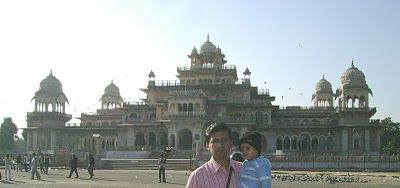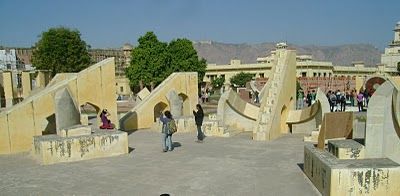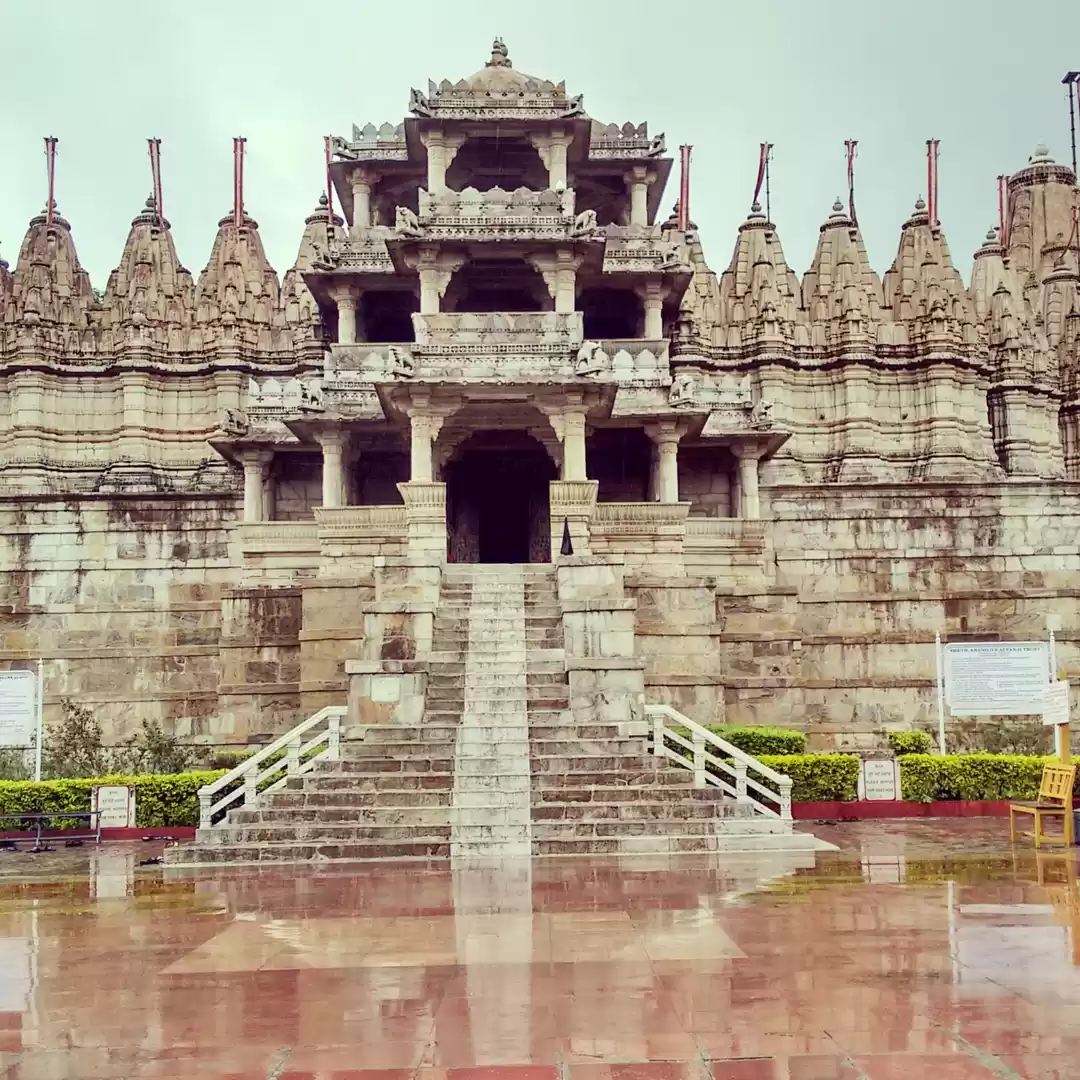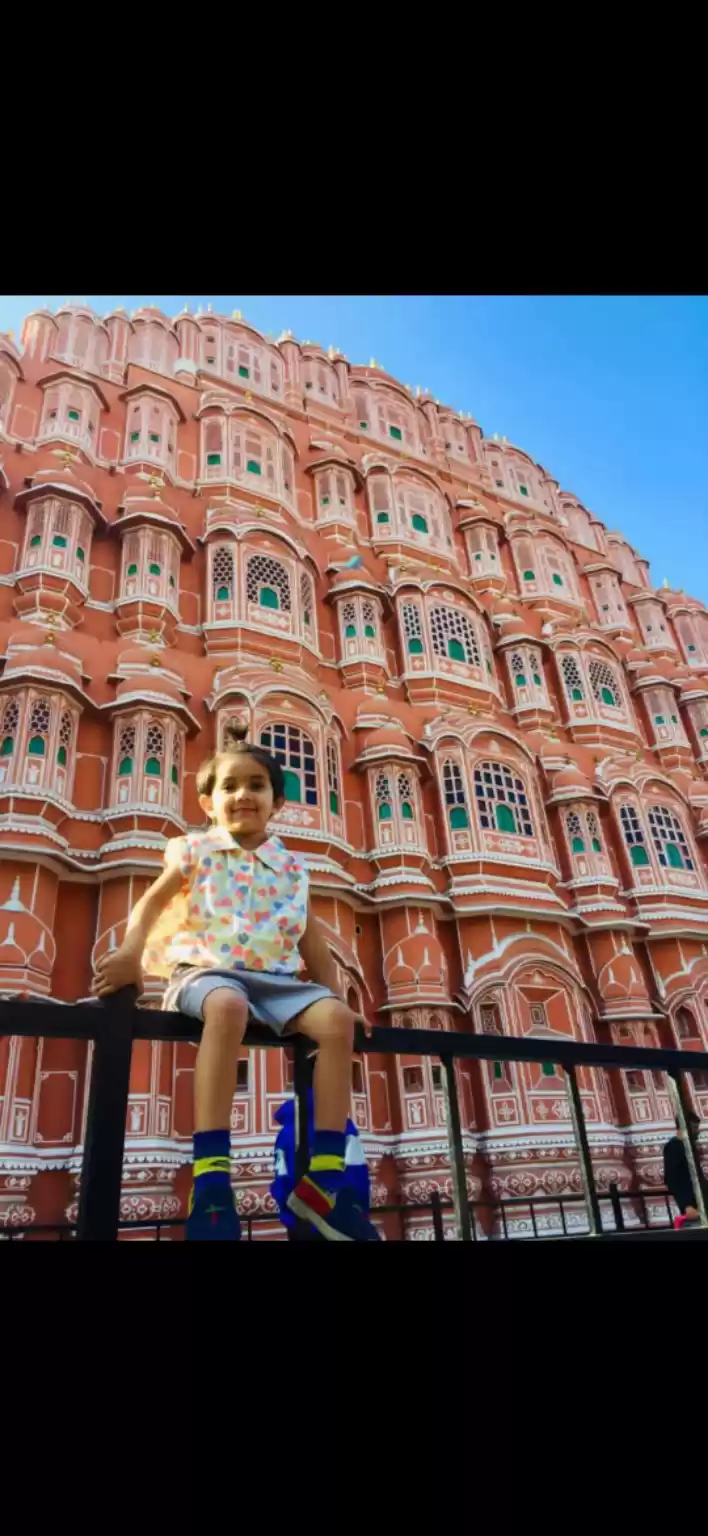



















Location: In the state of Rajasthan, located, 260 km from Delhi and 240 kms from Agra, Sanganer Airport is 15km south of townAlso called: The Pink CityFamous for: Handicrafts - Glittering gemstone and silver jewellery, Lac work, Meenakari, Metal work, Marble work, Paintings, Leather work, Gemstones, Carpets, Wood work, Tie and Dye textiles, Artefacts, Antiques, Apparel, Jaipuri quilts (rajai) and Local sweets and delicacies.Best time to visit: October - December. In the rains, it gets very messy and in the winter, it's quite chilly.Accommodation: Check http://www.rajasthantourism.gov.in , to find a listing to suit every budget.Our much awaited trip to the capital city, Jaipur was filled with awe and admiration. This state is famous for its wealth of forts, palaces and monuments. It is an epicenter for handicrafts too ! Founded by Maharaja Jai Singh II in 1727, the layout of the streets in this city was based on a mathematical grid of nine squares representing the ancient Hindu map of the universe, and the royal palace was placed symbolically at its centre. This city was said to have been painted pink in honour of a visit by Prince Albert in 1853.We opted for the full day tour of the city conducted by RTDC (Rajashtan Tourism Department Corporation) and set off to explore the rich monuments which are the:Hawa Mahal, Laxminarayan temple, Jantar Mantar, Albert Hall Museum, City Palace and Museum, Jaigarh fort, Nahargarh Fort, Amber Palace and fort.Tip: For those who have less time to spare, opt for the day tour (or the half day tour, see table below) conducted by RTDC, which covers most of the historical monuments in Jaipur. RTDC Sight seeing tour information:Half Day tour:Timings 0800 -1300 hrs11.30 -1630 hrs1330 -1830 hrsFare Rs.120/-Itinerary: Hawa Mahal (Front View), Amber Palace, Gaitore, City Palace, Observatory Full day tour:Timing: 0900 -1800 hrsFare: Rs. 170 /-Itinerary: Hawa Mahal (front View), Laxminarayan temple, Jantar Mantar, Central Museum, City Palace & Museum, Jaigarh fort, Nahargarh Fort (Lunch), Amber Palace and fort, Jal Mahal (front view), Kanak Vrindavan.For reservations for all tours contact RTDC at 0141-2375466, 2375835, 2371648, 2200778, 2315714, 2206720 (24 hours Tourist assistance on Tel .No. 1364)Tourist Information Bureau, Railway Station, Tel 91-141-2315714 RTDC Tourist Hostel, Old Govt. Hostel, M.I. Road, Jaipur, Tel 91-141-2375466Tourist Office, Hotel Khasa Kothi Tel: 91-141-2372200Say Yes to a Life with Zest !
Our Jaipur journey began with the landmark of the city, the Hawa Mahal , an imposing structure. The name literally means Palace of winds or Palace of the Breeze. Built 1799 by Maharaja Sawai Pratap Singh, and designed by Lal Chand Usta it depicts the form of the crown of Krishna, the Hindu god. The pyramidal shape combined with the numerous screened windows makes the structure look like a giant honeycomb. This 5 storied stunning semi-octagonal monument has 953 small windows called jharokhas, decorated with intrinsic lattice work and is a fine piece of Rajput architecture. The latticed windows allowed the royal ladies to view the everyday life in the street below from the palace without being seen. The beauty of the Hawa Mahal lies in its fragile appearance, which belies its strength. The interiors are connected by ramps and there are no stairs to reach the upper floors. A unique feature of the building is that it remains cool even during the harsh summers. This is due to the excellent ventilation that allows cool air to freely flow throughout the building. Situated on the main thoroughfare in the heart of Jaipur’s business centre, in the middle of the bustling Johari Bazaar, near the Badi Chaupad (the big square), this palace rises to a height of 50 feet. It is built of red and pink sandstone and forms a part of the City Palace, which was our next stop.

The City Palace in Jaipur, houses the largest silver vessels, which have been officially recorded by the Guinness Book of World Records. The two huge vessels weigh 340 kilograms (750 lb), are of 1.6 metres (5.5 feet) in height and have a capacity of 4000 litres. These were made from 14000 melted silver coins and are placed in the Diwan-I-Khas, private audience hall of the Maharajas. Specially made for Maharaja Sawai Madho Singh II, these vessels were used to carry the Ganga river water to drink on his trip to England in 1901 (for Prince Edward VII's coronation) Thus, the vessels were named as Gangajelies (Urns containing water of the Ganges). Maharaja Sawai Jai Singh II, ruled Amber kingdom from 1699-1744. He shifted his capital from Amber to Jaipur in 1727 due an increase in population and increasing water shortage. And initiated the construction of the City palace. The City palace is situated in the heart of the old Jaipur City, and it occupies about one seventh of the area. This palace complex showcases the grandeur of the royal past. It houses a series of courtyards, gardens and structures, the most prominent ones are: Diwan -E- Khas - or the 'Hall Of Private Audience'. After crossing the first square, one comes across this hall which was meant for private audience. The famous mammoth silver vessels are on display in this hall. Diwan-I-Aam - was meant for public audience, at present, is an art gallery which showcases enthralling painted ceilings and rare ancient handwritten original manuscripts of Hindu scriptures. Chandra Mahal - This seven storeyed palace, displays wonderful architecture with delicate paintings, floral decorations and mirror work on the walls. The topmost floor is known as Mukut Mahal. In the present day, this palace serves as the residence of ex-ruler. The complex contains an excellent museum of Maharaja Sawai Man Singh II and has an extensive collection of art, carpets, enamelware and old weapons. Badal Mahal - stands op

Located across the road from the City Palace, Jantar Mantar, was our next destination in Jaipur. It: - Was built between 1727 and 1733. - Is the largest stone astronomical observatory in the world ! - Has the biggest sundial in the world ! - Is one of the largest and the only working observatories of the five, built by Sawai Jai Singh II (the others were built in Delhi, Mathura, Benaras and Ujjain) - Houses a large collection of around 20, huge masonry astronomical instruments, each with a specific astronomical use. The main reason to build these large stone structures on a grand scale was to enhance the accuracy of the measurements. - Has been recently (in July 2010), added to the World Heritage list, by UNESCO, as a cultural site. - According to UNESCO, the site "is the most significant, most comprehensive, and the best preserved of India's historic observatories." As listed on the National Geographic site, the other astronomical site added to the World Heritage list is part of the monuments at "The Centre of Heaven and Earth"—a sacred mountain in China's Henan Province. The site includes the Zhougong Sundial Platform and the Dengfeng Observatory, built about 700 years ago at the beginning of the Yuan Dynasty (A.D. 1271-1368) by astronomer Guo Shoujing. Reference: http://blogs.nationalgeographic.com/ I admire our astronomers and masons of yesteryears who conceived and built these amazing masonry instruments used to study the movement of constellations and stars in the sky !

We started the Jaipur City tour, by first visiting, the famous Laxmi Narayan temple, or Birla temple. It was built in 1988, by the Birla Group of Industries, one of the business tycoons of India. Situated just below the Moti Doongri hill, in the southern part of Jaipur, one can get a beautiful view of the Moti Dongri fort, which was built like a Scottish castle, from this place. Constructed of pure white marble and surrounded by lush green gardens, this temple is dedicated to Lord Narayan (Vishnu), the preserver and his consort, Lakshmi devi, the Goddess of Wealth. The temple has attractive stained glass windows depicting scenes from the Hindu mythology and rich carvings in pure white marble. It also portrays great historical achievers, philosophers and religious saints such as Socrates, Zarathustra, Christ, Buddha, and Confucius. The three huge domes of the temple represent the different approaches to religion. One can reach this lovely temple, easily from the city, by taking the local bus, rickshaw or taxi. When walking barefoot * inside the temple, the coolness of the marble surface felt, under my feet, evoked a feeling of deep peace, satisfaction and gratitude towards life ! *one has to walk in, barefoot, whilst entering any of the temples in India, as a sign of respect to the deities in the temple. This also contributes significantly towards maintaining the cleanliness of the temple too!

Located amidst the gardens of Ram Niwas Bagh, it is also known as Albert Hall museum. Supposed to be the oldest museum of Jaipur, it was designed by Colonel Swinton Jacob in 1876 to greet King Edward VII (Prince of Wales) on his visit to India. It houses the various treasures of the rich bygone era ! Unfortunately, when we reached this museum, we learnt that it was closed for renovation . But we did get a chance to take a quick look at it from outside. This museum has been modeled on the Victoria and Albert Museum in London and has many pillars, courtyards and arches that give it a very traditional yet elegant look. One of the unique feature of the marble pillars of this museum was that different types of leaves have been depicted on each of the pillars, which is very interesting! Museum visiting hours: 10.30 am – 4.30 pm We wander for distraction, but we travel for fulfillment. - Hilaire Belloc

Our next stop was Jaigarh fort, which means the Fort of Victory, and is located 12 kilometres away from Jaipur. This colossal fort is the best of the three forts overlooking the city (the other two being the Amber and the Nahargarh forts) It is built atop a hill by Maharaja Jai Singh in 1726 A.D. While the Amber fort is situated at the bottom of the hill. Both the forts are well connected through guarded passages. Nestled amidst rock-strewn, thorny scrub-covered hills, this rugged fort, was a center of artillery production for the Rajputs. The highlight of the fort is the Jaivana, which is the world’s largest cannon on wheels! There is a vast collection of cannons in this fort. This fort also served as the royal treasury for a number of years. A huge moat surrounds the fort, too ! A striking museum is present in its premises,with an extraordinary collection of armoury used during the bygone era including swords, shield, guns, cannon balls etc. Another interesting feature is, the water channels built inside the fort – part of rainwater harvesting system ! There are a total of 3 underground tanks in the fort and the largest of them had the capacity to store 60,00,000 gallons of water. A 5 kilometre long canal can be seen entering the fort complex to bring in water from the high hills and store in the fort . A huge water tank is centrally located connecting the canal. Truly, a planning and engineering feat !

Frequent Searches Leading To This Page:-
jaipur 1 day tour package, holidays to jaipur, chetram voyages jaipur, package from jaipur, jaipur kumbhalgarh udaipur





































